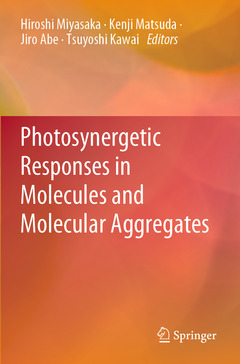Photosynergetic Responses in Molecules and Molecular Aggregates, 1st ed. 2020
Langue : Anglais

This book compiles the accomplishments of the recent research project on photochemistry ?Photosynergetics?, supported by the Ministry of Education, Culture, Sports, Science and Technology of Japan, aiming to develop and elucidate new methods and molecules leading to advanced utilization of photo-energies. Topics include photochemical responses induced by multiple excitation, multiphoton absorption, strong modulation of electronic states, developments of new photofunctional molecules, mesoscopic actuations induced by photoexcitation, and novel photoresponses in molecules and molecular assemblies. The authors stress that these approaches based on the synergetic interaction among many photons and many molecules enable the expansion of the accessibility to specific electronic states. As well, they explain how the development of reaction sequences and molecules/molecular assemblies ensure ?additivity? and ?integration? without loss of the photon energy, leading to new photoresponsive assemblies in meso- and macroscopic scales.
Advanced control of photochemical reactions leading to synergetic responses in molecules and mesoscopic materials.- Advanced electronic structure theory for high accuracy prediction of higher excited states and its application to photochromic molecules.- Enhanced and selective two-photon excitation of molecular vibronic states using entangled photons.- Stepwise two-photon photochromism.- Suppression of internal conversions from pseudo-degenerate excited electronic states.- Advanced function control of photochemical reactions using mesoscopic structures.- Plasmon-associated control of chemical reaction at nanometer scale.- Modulations of electronic states in plasmonic strong coupling systems and their application to photochemical reaction fields.- Photosynergetic effects on triplet-triplet annihilation upconversion processes in solid studied by theory and experiments.- Hot carrier transfer and carrier manipulation of semiconductor nanocrystals.- The confinement and migration of charge carriers in halide perovskites.- Plasmon induced carrier transfer for infrared light energy conversion.- Controlling optical properties of multinary quantum dots for developing novel photoelectrochemical reactions.- Photosynergetic enhancement of photosensitivity of photochromic terarylenes.- Creation of molecularly integrated multi-responsive photochromic systems.- Efficient singlet fission in acene-based molecular assemblies.- Synergetic photon upconversion realized by a controlled toroidal interaction in hexaarylbenzene derivatives.- π-Electronic ion-pairing assemblies for photoswitching materials.- Photoinduced morphological transformation and photodriven movement of objects using self-assembly of amphiphilic diarylethene in water.- Functional photoactive materials based on flexible π molecules.- Giant amplification of fluorescence.- Cooperative molecular alignment process enabled by scanning wave photopolymerization.- Ultrafast energy transfer of biohybrid photosynthetic antenna complexes in molecular assembly systems.- Biomimetic functions by microscopic molecular reactions in macroscopic photoresponsive crystalline system.- Photoresponsive molecular crystals for light-driven photoactuators.- Interplay of photoisomerization and phase transition events provide a working supramolecular motor.- Development of photoresponsive solid-liquid phase transition systems based on synergetic action of molecules.- Photomechanical effects in crosslinked liquid-crystalline polymers with photosynergetic processes.- Femtosecond pump-probe microspectroscopy and its application to single organic nanoparticles and microcrystals.- Single-molecule level study and control of collective photoresponse in molecular complexes and related systems.- Cooperative and hierarchal photoresponses of molecular assembling processes probed by organic fluorescent molecules.- Fabrication of charge-transfer complex nanocrystals toward electric field-induced resistive switching.- Turn-on mode photoswitchable fluorescent diarylethenes for super-resolution fluorescence microscopy.- Crystallization control of the photoresponsible diarylethene film with an aluminum plasmonic chip.
Hiroshi Miyasaka received his Ph.D from Osaka University in 1985. His research interests include ultrafast dynamics of molecules in the electronically excited state, multiple-photon excitation for the control of photochemical reaction, and detection of individual molecules by optical methods. He is currently a full professor at Graduate School of Engineering Science in Osaka University. He published more than 250 articles and some 30 book chapters. He won the Japanese Photochemistry Award and Masuhara Lectureship Award of Asian and Oceanian Photochemistry Association.
Kenji Matsuda received his Ph.D from the University of Tokyo in 1997. His research interests include physical organic chemistry for molecular electronics and highly functional materials. He is currently a full professor at Graduate School of Engineering in Kyoto University. He published more than 200 articles, reviews, and book chapters. He won the Chemical Society of Japan Award for Young Chemists, Nozoe Memorial Award for Young Scientist, and Japanese Photochemistry Association Award.
Jiro Abe has received his Ph. D from Waseda University in 1991. His research interests include the development of fast photoswitchable molecules, and investigation of photochemical dynamis by time-resolved spectroscopies and DFT calculations. He is currently a full professor at College of Science and Engineering in Aoyama Gakuin University. He published more than 140 articles, and contributed 6 book chapters. He won the Japanese Photochemistry Award in 2012.
Tsuyoshi Kawai has received PhD from Osaka University in 1993. He is currently a full professor at Nara Institute of Science and Technology, NAIST. His research interests include development of photoreactive molecules and luminescent materials. He has published more than 350 papers on the topics of organic functional compounds and nano-scale mater
Lists appropriate references to introduce new photochemistry research results to readers unfamiliar with the subject Includes chapters to help readers understand the concept of photosynergetics Gives a basic introduction to the background of the research in each chapter to facilitate readers’ understanding
Date de parution : 09-2021
Ouvrage de 593 p.
15.5x23.5 cm
Date de parution : 09-2020
Ouvrage de 593 p.
15.5x23.5 cm
Thème de Photosynergetic Responses in Molecules and Molecular... :
© 2024 LAVOISIER S.A.S.



